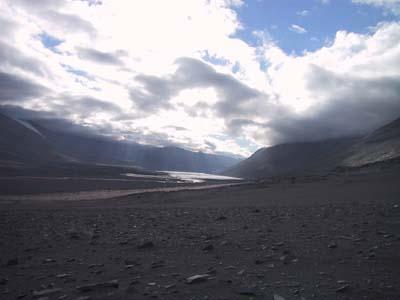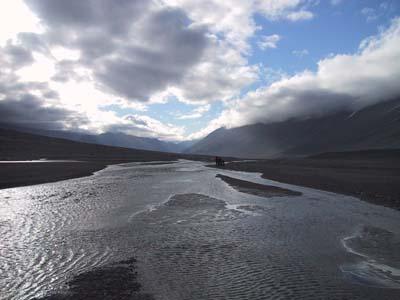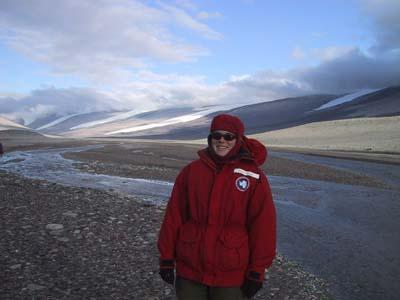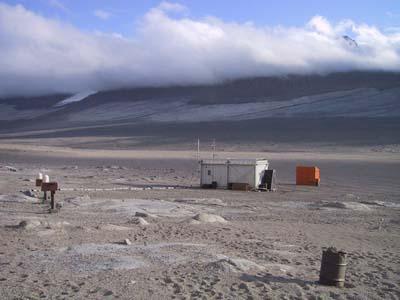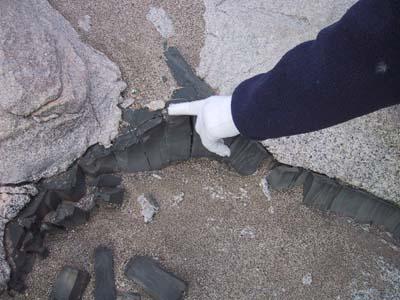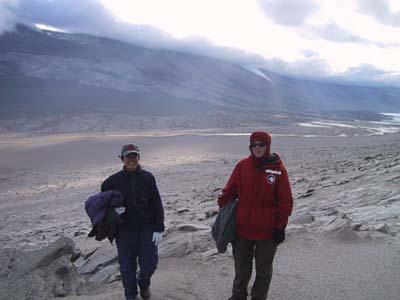
|
25 January, 2003Onyx River At the bottom of Wright Valley is the longest river in Antarctica, the Onyx River. Taber, Karina, Sarah, and I decided to hike down to it after dinner. It's only about a mile or two away. The Onyx River gets its name not from the semiprecious stone as you might guess but rather from the ".juxtaposition of the letters O, N, Y and X." according to Colin Bull who led a New Zealand expedition to the region in the late 1950's. Colin Bull and the other three members of his 1959 team were the first to explore the Wright Valley. Much of the surrounding terrain and glaciers are named by these men including areas named after them (such as Bull Pass). The other members were Barrie McKelvey, Peter Webb, and Richard Barwick. The Onyx River is an 18-mile long melt water stream that flows into Lake Vanda from a glacier at the end of the valley. The ice-covered Lake Vanda is almost 200 feet deep and over 70 degrees Fahrenheit at the bottom. From 1968-1995 the Kiwis extensively studied Lake Vanda from a research station they had constructed. The deep section of the Lake is extremely saline and because there isn't any mixing the denser salt water remains at the bottom. The thick ice that forms at the top includes crystals that transmit solar energy down the crystals and to the deeper sections. Sarah's father, in fact, was one of the researchers who studied the climatic changes that could be revealed by analyzing sediment cores taken from the bottom of the Lake. He was here in the early 1970's. Don Juan Pond, also in the Wright Valley, is only 10cm deep. It is the most saline lake in Antarctica, so salty that it never freezes (even at -60 degrees Fahrenheit). White crusts of calcium salt crystals and of a rare mineral called antacticite precipitate on Don Juan Pond's shores. Although the valleys appear lifeless, they harbor some of the most remarkable organisms on Earth. In 1976, American biologists discovered algae, bacteria and fungi growing inside Dry Valley rocks. This "endolithic" vegetation grows in the air spaces in porous rocks. Light, carbon dioxide and moisture penetrate the rock, and the rock protects the organisms against excessive drying and harmful radiation. Some of these plants are believed to be 200,000 years old. Antarctic Tidbits: A domestic deep freeze runs at about -4 degrees F. The mean summer temperature on the great East Antarctica icecap is -22 degrees F and mean winter temperature around -76 degrees F. The lowest ever temperature recorded was at the Russian Vostok station, -129 degrees F. When the Antarctic sea-ice begins to expand at the beginning of winter, it advances by around 40,000 square miles (100,000 square kilometers) per day, and eventually doubles the size of Antarctica, adding up to an extra 20 million square kilometers of ice around the land mass. That's one and a half USA's, two Australia's or 50 UK's worth of ice area that forms, then breaks up and melts on an annual basis. Snow falling at the South Pole takes about 100,000 years to "flow" to the coast of Antarctica before it drops off the end as part of an iceberg. Source: http://www.coolantarctica.com/Antarctica%20fact%20file/fascinating_facts_about_antar.htm
Contact the TEA in the field at . If you cannot connect through your browser, copy the TEA's e-mail address in the "To:" line of your favorite e-mail package. |





